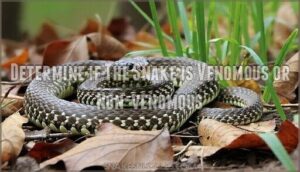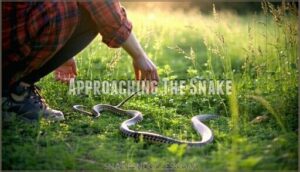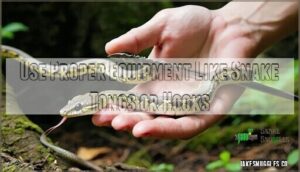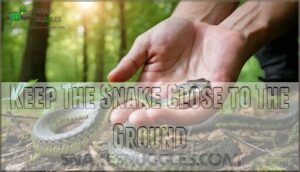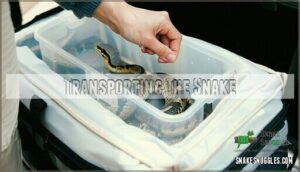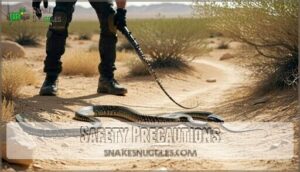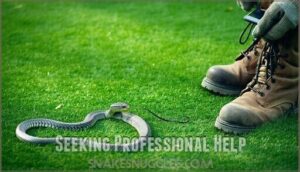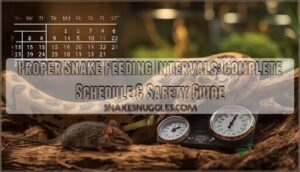This site is supported by our readers. We may earn a commission, at no cost to you, if you purchase through links.
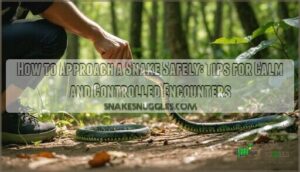
Keep a safe distance, and avoid sudden movements that might startle it. Approach slowly and calmly, from the side rather than head-on, as direct eye contact can feel threatening to the snake.
Use a long object, like a stick, to gently distract it if needed. Never grab it by the neck; instead, support its body fully if handling is necessary.
Always prioritize your safety and the snake’s well-being. Curious about handling tools or safe transport tips? There’s more to explore ahead!
Table Of Contents
- Key Takeaways
- How to Approach a Snake?
- Identifying The Snake
- Approaching The Snake
- Handling The Snake
- Transporting The Snake
- Releasing The Snake
- Safety Precautions
- Seeking Professional Help
- Frequently Asked Questions (FAQs)
- What should you do if you encounter a snake in the wild?
- How do you handle a snake without stressing it?
- How do I learn the basics of snake handling?
- What if you encounter a snake?
- Do you need to handle a snake?
- How can I prepare for a snake encounter?
- What is the best way to approach a snake?
- How do you get a snake to trust you?
- How to greet a snake?
- Will a snake approach you?
- Conclusion
Key Takeaways
- Keep a safe distance and approach the snake slowly from the side to avoid startling it.
- Identify the snake first to determine if it’s venomous; always assume it’s dangerous if unsure.
- Use tools like a stick or snake hook to distract and handle it safely without grabbing its neck.
- For transport, place the snake in a ventilated container and release it in a natural, sheltered area away from people.
How to Approach a Snake?
When approaching a snake, always maintain a safe distance to observe its body language.
Always keep a safe distance and read the snake’s body language to ensure a calm and secure encounter.
Move with slow movements and a calm approach to avoid startling it.
Approach from the side, not head-on, as snakes rely on psychology to assess threats.
Use a long object to distract it during your first encounter, ensuring a controlled and safe approach.
Identifying The Snake
When you spot a snake, identifying it’s the first step to staying safe. Pay attention to its physical features and behavior to determine if it’s venomous or harmless.
Determine if The Snake is Venomous or Non-venomous
To identify venomous snakes, check for triangular heads, vertical pupils, and thick bodies, but remember exceptions like coral snakes with rounded heads and pupils.
Venomous snakes often have triangular heads and vertical pupils, but exceptions like coral snakes remind us identification isn’t always foolproof.
Nonvenomous snakes often have slender bodies and round pupils.
Use regional knowledge and snake morphology for accuracy, and avoid close contact—venomous identification isn’t foolproof.
When uncertain, always assume the snake is venomous and maintain safety.
Observe The Snake’s Behavior and Body Language
Reading snake signals helps you understand their mood.
Look for defensive postures like coiling, hissing, or striking, which show stress indicators.
A calm demeanor on your part can prevent escalation during a snake encounter.
Environmental influence matters too—snakes may act defensively if cornered or startled.
Observing body language guarantees safer snake handling, as it reveals whether the snake feels threatened or relaxed, and helps in understanding the snake’s overall mood.
Keep a Safe Distance and Avoid Sudden Movements
Keeping a safe distance during a snake encounter is non-negotiable. Snakes can strike faster than you’d think, so stay at least 6 feet away.
A calm demeanor helps avoid provocation.
Follow these steps:
- Maintain a passive approach—let the snake feel unthreatened.
- Avoid sudden movements; they trigger defensive reactions.
- Gradually retreat if needed, prioritizing snake safety and yours.
Approaching The Snake
When approaching a snake, move slowly and stay calm to avoid startling it. Always come from the side, not head-on, to reduce the chance of being seen as a threat.
Approach The Snake Slowly and Calmly
When you spot a snake, take a calm approach. Slow movements are key to avoiding provocation.
Respectful distance helps you gauge its body language without causing stress. A steady, deliberate snake approach shows calmness and prevents defensive reactions.
Snake awareness and safety precautions, like moving gradually, guarantee a smooth encounter. Handling techniques start with patience and maintaining the snake’s comfort.
Avoid Making Direct Eye Contact
When approaching a snake, avoid direct eye contact—it’s not a staring contest! Snakes perceive prolonged gazes as a predator’s threat.
Instead, focus on these steps:
- Look slightly away to reduce tension.
- Keep your movements slow and deliberate.
- Stay calm to avoid startling the snake.
- Observe its body language subtly.
- Respect its space to guarantee safety.
Remember to review snake handling techniques before any encounter to ensure you are prepared for a safe interaction.
Approach From The Side, Not Head-on
Snakes rely on predator avoidance and defensive postures when they feel threatened.
Approaching from the side, rather than head-on, minimizes the threat you pose.
Direct approaches can trigger defensive behavior due to their limited snake vision.
The side approach benefits include keeping the snake calmer, as it perceives less danger.
This snake handling technique guarantees safer, more controlled interactions, respecting natural snake behavior.
Use a Long Object to Distract The Snake
Using a long object like a broom or snake hook can help with distraction safety. Gently nudge the snake to guide its movement, keeping your distance.
A mosquito net attached to a handle works well for capturing it safely. These handling techniques allow alternative methods to direct the snake without risk.
Tool selection is key—choose sturdy, safe options for nudging techniques. A specialized tool, like a quality snake hook, can greatly improve safety with the use of a snake hook.
Handling The Snake
When handling a snake, you’ll need to stay calm and use the right tools like tongs or hooks.
Always support its body fully, lifting it gently while keeping it close to the ground for safety.
Use Proper Equipment Like Snake Tongs or Hooks
When handling snakes, rely on snake handling tools like snake tongs or hooks to maintain distance and guarantee safety.
Hooks are gentler on the snake’s spine, while tongs provide a firmer grip—choose based on your comfort and the species.
Regularly inspect your snake handling equipment for damage.
Consider using specialized snake hooks for enhanced control.
Always prioritize a safe grip technique and proper maintenance to avoid accidents.
Grab The Snake Firmly but Gently Around The Middle
A firm grip is key when handling snakes, but pressure control matters. Grab the snake gently around the middle to avoid injury. Safe tools like hooks can help, but your hands must provide steady support. Never squeeze too tightly, as it causes stress.
Understanding snake behavior is essential for safe handling, and can be found at Understanding snake behavior.
- Hold firmly, not forcefully.
- Avoid grabbing the neck.
- Keep movements slow.
- Always prioritize the snake’s comfort.
Support The Snake’s Body Fully When Lifting
When lifting a snake, make certain its body is fully supported to prevent injury.
Use both hands—one near the mid-body and the other closer to the tail.
This even weight distribution guarantees gentle handling and a secure grip.
Avoid squeezing or leaving parts unsupported, as this can stress the snake.
The goal is to provide a secure grip and ensure the snake feels safe and comfortable during handling.
| Key Area | Action | Why It Matters | Result |
|---|---|---|---|
| Mid-Body | Support firmly | Prevents injury | Snake feels secure |
| Tail End | Provide gentle lift | Balances weight | Reduces stress |
| Grip Strength | Gentle but firm | Avoids squeezing | Ensures comfort |
| Handling Style | Use two hands | Even weight distribution | Safe, controlled handling |
Handling a snake requires attention to even weight distribution and careful consideration of the snake’s well-being to prevent injury and ensure a positive experience for both the handler and the snake.
Keep The Snake Close to The Ground
Keeping the snake close to the ground guarantees reduced stress and secure handling.
After supporting its body fully, maintain ground proximity to prevent escapes or injuries.
Follow these snake handling techniques:
- Hold it gently but firmly.
- Let it move naturally.
- Avoid raising it above waist height.
- Stay calm and focused for safe snake handling.
Transporting The Snake
When transporting a snake, your main goal is to keep it safe and secure.
Use a well-ventilated container, and make sure it’s kept away from heat or sunlight during the journey.
Place The Snake in a Secure Container
After lifting the snake safely, place it into a sturdy snake container with a secure lid to prevent escape.
Use a snake hook if needed, and avoid placing your hands near any ventilation holes.
Consider purchasing a suitable snake carrier for safe transport.
Keep the container stable during snake transport, away from direct heat or sunlight.
Proper snake handling guarantees injury prevention and smooth, safe transport.
Ensure The Container Has Proper Ventilation
A well-ventilated snake container is essential for airflow design, preventing suffocation and maintaining proper humidity control.
Choose sturdy materials with secure ventilation holes small enough to avoid escape.
Poor ventilation can stress the snake, so make certain the container balances fresh air and safety.
Proper snake handling techniques start with reliable snake handling equipment, including a thoughtfully designed container that ensures proper humidity control.
Keep The Container Away From Direct Heat or Sunlight
To guarantee safe transport, keep the container out of direct heat or sunlight.
Excessive warmth can stress the snake, affecting its health. Choose a material that doesn’t overheat, like plastic with proper ventilation.
Temperature regulation is key for snake handling safety. These precautions help reduce stress, guaranteeing the snake remains calm and secure during transit, which is crucial for its overall well-being.
Transport The Snake to a Safe Location
Once the transport container is secure and away from heat, focus on safe handling during relocation.
Choose a quiet route to avoid jostling the snake. Habitat selection matters—pick a location far from people, like a wooded area.
Keep the container ventilated to prevent overheating. Use proper snake handling techniques to guarantee a smooth journey and minimize stress for the snake.
Releasing The Snake
When it’s time to release the snake, choose a quiet, natural spot far from people and buildings.
Gently place it in a sheltered area with plenty of cover, then step back to let it adjust.
Choose a Suitable Habitat Away From Human Activity
Pick a habitat release spot that’s safe for the snake and supports ecosystem balance. Look for areas with natural cover, food, and water, away from human activity.
Avoid roads, buildings, or busy spaces to protect both the snake and people.
- Choose wooded or grassy areas.
- Avoid disturbed or polluted sites.
- Prioritize spaces with minimal predators.
Respect the snake’s natural habitat selection.
Gently Release The Snake in a Sheltered Area
When releasing the snake, choose a sheltered spot with dense foliage or ground cover.
Gently tilt the container, allowing the snake to exit on its own, this habitat release technique minimizes stress and supports snake wellbeing.
Avoid sudden movements, and step back to observe post-release monitoring, a calm, thoughtful approach guarantees a smooth relocation while respecting the environment and the snake, ensuring a smooth relocation.
Avoid Releasing The Snake Near Roads or Buildings
When choosing a spot for a sheltered release, steer clear of roads or buildings.
Urban snake release near human activity increases risks of accidents and human-wildlife conflict.
Habitat suitability matters—snakes need safe spaces to thrive without disrupting ecosystems.
Prioritize snake relocation ethics by finding natural areas far from road proximity, ensuring both the snake’s safety and a balanced environment.
Maintaining yards by mowing grass regularly can also prevent snakes from settling nearby, which supports the goal of maintaining a balanced environment and promotes human-wildlife conflict prevention.
Monitor The Snake’s Behavior After Release
After releasing the snake, keep an eye on its post-release behavior to verify it’s adapting well to the environment.
Watch for signs of stress or disorientation.
- Check if it moves naturally into the habitat.
- Confirm it avoids predators or unsafe areas.
- Confirm it finds shelter for long-term survival.
Behavior monitoring helps protect the snake’s wellbeing and environmental adaptation.
Safety Precautions
When approaching a snake, your safety should always come first. Wear protective clothing, avoid grabbing the snake by the neck, and know what to do if bitten.
Wear Protective Clothing Like Thick Gloves
Protective clothing is your best friend during snake handling.
Snake handling gloves made of sturdy, bite-resistant materials are a must.
Look for:
- Thick leather or reinforced fabric for durability.
- Non-latex options if you’ve got allergies.
- Extended cuffs to shield your forearms.
- Breathable designs for comfort in warm weather.
- Rugged boots to protect your feet and ankles.
Avoid Grabbing The Snake by The Neck
When handling snakes, avoid grabbing their neck.
It can cause neck injury, provoke defensive strikes, and escalate stress.
Snakes rely on their anatomy for balance, so a proper grip around the mid-body guarantees safe handling.
This snake handling technique reduces risks and promotes calm interactions.
Respect their structure and use safe handling precautions to prevent unnecessary snake handling risks.
Seek Immediate Medical Attention if Bitten
If a snake bite occurs, act fast. Seek immediate medical care, especially for venomous bites. Call for help and avoid panic.
Remember to follow snake bite first aid procedures. Key steps include:
- Stay still to slow venom spread.
- Keep the bite below heart level.
- Avoid ice or tourniquets.
- Note bite symptoms for doctors.
- Prioritize antivenom access and infection prevention.
Quick action saves lives.
Seeking Professional Help
If you’re unsure how to handle a snake safely, it’s best to call a professional.
Experts like wildlife authorities or herpetologists can guarantee the situation is managed without harm to you or the snake.
Contact Local Wildlife Authorities or Animal Control
When a snake encounter feels unsafe, reach out to wildlife authorities or animal control for professional assistance.
These experts handle snake relocation with proper tools, ensuring everyone’s safety.
They’re trained to address safety concerns while following local regulations.
Don’t risk injury—let wildlife control manage the situation efficiently and humanely.
Always prioritize expert intervention over attempting it yourself.
Consult With a Herpetologist or Snake Expert
When in doubt about species identification or safe handling, reach out to a herpetologist or snake expert.
Their expert guidance guarantees ethical considerations and safety for both you and the snake.
- Learn about venomous snakes from professionals.
- Gain practical skills through professional training.
- Avoid mishandling with expert consultation.
- Protect wildlife by following ethical advice.
Avoid Attempting to Handle Venomous Snakes
Never try handling venomous snakes yourself—it’s not worth the risk.
Proper Venom ID is tricky, and one wrong move can lead to dangerous bite symptoms.
Instead, focus on prevention tips like snake avoidance and keeping a safe distance.
If bitten, seek antivenom access immediately. Protective snake gaiters can offer additional leg protection.
Leave snake handling venomous situations to professionals trained in snake identification and first aid. Stay safe!
Prioritize Safety When Dealing With Snakes
Your safety comes first when dealing with snakes. Always maintain a safe distance and wear protective gear like gloves.
A calm demeanor helps avoid startling them. Follow snake safety guidelines—don’t take risks with venomous species.
If bitten, seek emergency response immediately. For tricky situations, rely on expert assistance.
Snake handling precautions guarantee both your safety and the snake’s well-being.
Frequently Asked Questions (FAQs)
What should you do if you encounter a snake in the wild?
Stay calm and keep a safe distance.
Move slowly backward without turning your back. Avoid sudden movements or loud noises.
Let the snake retreat naturally, and don’t attempt to handle it. Call professionals if needed.
How do you handle a snake without stressing it?
Handle a snake calmly by supporting its body with both hands, avoiding sudden moves.
Approach from the side, not above, and let it stabilize on you.
Keep movements smooth, respecting its boundaries to minimize stress.
How do I learn the basics of snake handling?
Over 3,000 snake species exist, so start by learning their behaviors and body language.
Join workshops, observe experienced handlers, and practice with non-venomous snakes.
Always handle calmly, support their body, and respect their boundaries.
What if you encounter a snake?
If you encounter a snake, stay calm, back away slowly, and give it space.
Avoid sudden movements or loud noises.
Most snakes aren’t aggressive and will leave if they don’t feel threatened.
Do you need to handle a snake?
Imagine holding a coiled spring—tense but controlled.
You only need to handle a snake if it’s necessary, like relocating it safely.
Always prioritize safety, use proper tools, and respect the snake’s boundaries.
How can I prepare for a snake encounter?
Stay calm and aware of your surroundings.
Wear protective gear like boots and gloves if possible. Keep a safe distance, move slowly, and avoid sudden movements.
Learn to identify local species for better preparation.
What is the best way to approach a snake?
Approach like you’re meeting a shy neighbor—slowly, calmly, and from the side.
Avoid sudden moves or direct eye contact.
Keep a safe distance, read its body language, and let it feel unthreatened.
How do you get a snake to trust you?
Build trust by handling your snake calmly and regularly.
Move slowly, support its body fully, and avoid sudden movements.
Let it explore your hands, respect its boundaries, and always prioritize its comfort over your curiosity.
How to greet a snake?
Picture calm hands and steady movements as you extend your presence near the snake.
Approach from the side, not above, avoiding sudden gestures.
Let the snake sense your warmth and intentions without rushing the interaction.
Will a snake approach you?
Snakes rarely approach humans on purpose.
They’re naturally shy and prefer to avoid confrontation.
If one seems to move toward you, it’s likely curious or mistaking you for warmth or shelter, not aggression.
Conclusion
Approaching a snake requires patience, awareness, and proper technique.
Stay calm, move slowly, and always prioritize safety.
Identify the snake first—knowing if it’s venomous is essential.
Use tools like tongs or hooks for handling, and never grab it by the neck.
Support its body fully to avoid harm.
For transport, secure it in a ventilated container and release it in a safe habitat.
By following these steps, you’ll know how to approach a snake safely and responsibly.

